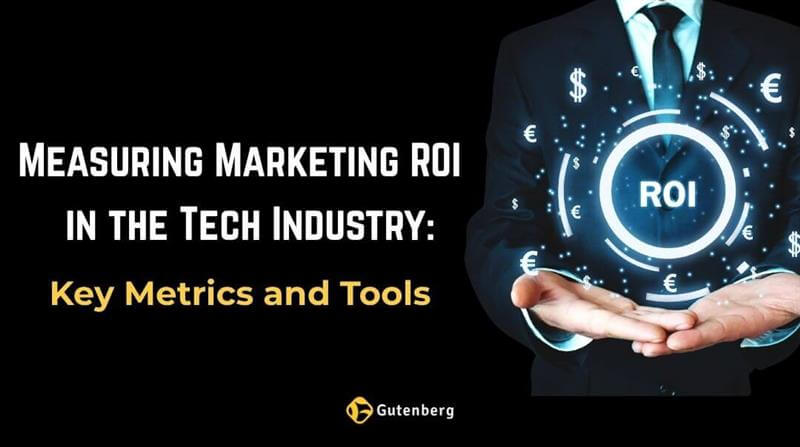Measuring Marketing ROI in the Tech Industry is a mission-critical task, but it’s rarely straightforward. With long sales cycles, complex product ecosystems, and multiple decision-makers, proving marketing impact can feel like chasing shadows. Without the right metrics and tools, tech marketers risk flying blind.
Unlike consumer-driven industries, the tech sector faces unique challenges in quantifying marketing success. Buyers interact with multiple touchpoints over weeks or months before converting. This means basic vanity metrics alone won’t offer enough clarity. Companies need to look deeper.
In this blog, we’ll explore how to define and measure Marketing ROI in the Tech Industry, the most relevant tech marketing metrics, tools that make tracking easier, and practical ways to improve ROI visibility. We’ll also discuss common pitfalls that distort measurement and how a partner like Gutenberg can bring clarity to your strategy.
Why ROI Is Harder to Track in Tech
Measuring Marketing ROI in the Tech Industry isn’t as simple as matching ad spend with new revenue. With complex product offerings, long decision-making cycles, and often multiple stakeholders involved in the purchase process, connecting marketing activities directly to closed deals becomes challenging.
In tech, many conversions happen offline or later in the sales funnel. That means your attribution model and data systems need to account for these delays. Without that, you risk underestimating your marketing impact.
Key Tech Marketing Metrics That Actually Matter
To get a clear picture of Tech industry ROI, companies need to go beyond surface-level numbers. Here are the metrics that truly help assess performance:
Customer Acquisition Cost (CAC):
This metric shows how much it costs to acquire a customer through marketing. It’s calculated by dividing total marketing spend by the number of customers gained in that period. When CAC is high and not matched by lifetime value, ROI suffers.
Customer Lifetime Value (CLV):
CLV helps put acquisition costs into perspective. A higher CLV than CAC means marketing is contributing to sustainable growth. For SaaS and B2B tech businesses, tracking CLV is especially important to understand long-term returns.
Marketing Qualified Leads (MQLs) to Sales Qualified Leads (SQLs):
This conversion rate reveals whether your marketing efforts are attracting the right audience. A poor MQL-to-SQL ratio may indicate a disconnect between lead generation and actual sales readiness.
Conversion Rates Across the Funnel:
Break down the conversion rate at each funnel stage to identify drop-off points. It’s not enough to look at final conversions; understanding mid-funnel activity is crucial in tech.
Return on Ad Spend (ROAS):
While ROAS doesn’t give the full ROI picture, it does show the efficiency of paid media campaigns. It’s particularly useful for campaign-level evaluation.
Channel-Specific Performance Metrics:
Measure traffic, engagement, and conversions from each channel. This helps prioritize platforms that yield the best returns.
Attribution Models and Assisted Conversions:
Relying solely on first- or last-touch attribution can be misleading. Multi-touch attribution models provide a more balanced view, especially in tech, where the buyer journey is longer.
Tools That Help Tech Companies Measure ROI Effectively
Selecting the right tools makes it easier to gather accurate data and act on it. Here are some of the most effective marketing tools for tech companies:
- Google Analytics 4: Ideal for tracking web traffic and user behavior. GA4 also offers better cross-device tracking and event-based data collection, both of which are helpful for tech businesses with complex funnels.
- HubSpot: HubSpot combines CRM and marketing automation with detailed dashboards. It’s particularly effective for tracking MQL to SQL progression and email marketing performance.
- Salesforce Marketing Cloud: With deep CRM integration, it allows full-funnel visibility from lead generation to deal closure. A strong choice for large tech firms.
- Looker and Tableau: These data visualization platforms turn raw numbers into clear insights, allowing for executive-friendly ROI reporting.
- UTM Builders and Campaign Trackers: Tracking URLs helps attribute results to specific campaigns and channels. A must-have for accurate reporting.
A study by Forbes states that companies using integrated marketing analytics tools were 1.7x more likely to exceed revenue goals.
How to Improve ROI Tracking in the Tech Sector
Even with the right tools, many companies struggle with poor measurement practices. To improve how you’re measuring ROI in technology, follow these foundational steps:
- Unify Sales and Marketing Data: Ensure both teams are tracking activities in the same system. Misalignment here leads to inconsistent ROI reports.
- Set Clear Goals for Each Campaign: Before launching any campaign, define what success looks like. Tie goals back to broader business metrics.
- Use Multi-Touch Attribution: Choose an attribution model that reflects the complexity of tech sales. Don’t give all credit to a single channel or touchpoint.
- Track Funnel Metrics Continuously: Set up dashboards that update in real-time or weekly. Waiting until quarter-end often means missing optimization opportunities.
- Avoid Vanity Metrics: Focus on KPIs that actually tie to revenue. High impressions or likes don’t mean much if they don’t convert.
Common ROI Measurement Mistakes in Tech
Even well-intentioned teams fall into traps that distort ROI results. These are the most common:
- Not tracking offline or sales-assisted conversions
- Relying on outdated attribution models
- Measuring too many metrics with no clear strategic connection
- Ignoring retention and customer expansion when calculating returns
- Evaluating campaign success too early
Fixing these issues often requires a reset in how success is defined internally.
Why Tech Companies Work with Gutenberg
Measuring Marketing ROI in the Tech Industry doesn’t need to be overly complicated. But it does require the right structure, tools, and approach. That’s where Gutenberg comes in.
Gutenberg helps tech companies define success early on, build clear tracking systems, and bring consistency to ROI reporting. We don’t just recommend metrics — we help implement them. Our integrated reporting and performance marketing support is tailored specifically to tech firms that need to connect marketing spend to revenue more clearly.
From campaign design to attribution modeling, Gutenberg equips marketing teams with what they need to report better and perform better. If ROI clarity is what your team is missing, it’s time to talk.
Explore how Gutenberg can help you measure marketing performance with purpose: Explore Our Solutions
Conclusion
Understanding and improving Marketing ROI in the Tech Industry is less about getting a perfect number and more about building a reliable process. With longer sales cycles and complex decision paths, the tech space requires more thoughtful measurement.
By focusing on the right tech marketing metrics, using reliable marketing tools for tech companies, and fixing common blind spots, teams can make data-backed decisions that move the needle.
Whether you’re refining attribution, reevaluating CAC, or setting up a full-funnel dashboard, every step brings you closer to smarter marketing. And if you need a partner to help simplify the process, Gutenberg is here to support that journey.
Frequently Asked Questions
What metrics should tech companies focus on to measure marketing ROI?
To measure Marketing ROI in the Tech Industry, companies should track Customer Acquisition Cost (CAC), Customer Lifetime Value (CLV), MQL to SQL conversion rate, funnel performance, and Return on Ad Spend (ROAS). These metrics give a clearer view of marketing effectiveness.
Which tools can help track marketing ROI for tech companies?
Google Analytics 4, HubSpot, Salesforce Marketing Cloud, Looker, and campaign tracking tools are widely used for monitoring Tech industry ROI. These tools make it easier to link marketing efforts to business outcomes.
Why is ROI tracking more complex for tech companies?
Longer sales cycles, multiple stakeholders, and delayed conversions make it harder to directly attribute marketing to revenue. That’s why tech companies need integrated data systems and more advanced attribution models to effectively measure Marketing ROI in the Tech Industry.
Are there agencies that help tech companies measure marketing ROI more effectively?
Yes. Some agencies specialize in aligning marketing performance with revenue goals by implementing better tracking tools, custom dashboards, and multi-touch attribution. This is especially useful for measuring ROI in technology sectors where standard models often fall short.
What kind of support can agencies provide to improve ROI tracking?
Agencies like Gutenberg help tech companies set up structured reporting, define meaningful metrics, and bring consistency to performance analysis. They simplify the entire process of measuring Marketing ROI in the Tech Industry, making it easier to act on real data.
















